Super Flower Leadex Gold 550W PSU Review
Super Flower has made quite an impact on the PSU market. Its Leadex platform enjoys huge popularity, both under SF's brand name and other companies like EVGA. The newest Leadex Gold-rated PSU with 550W capacity is on our test bench today.
Why you can trust Tom's Hardware
A Look Inside And Component Analysis
Parts Description
Before proceeding with this page, we strongly encourage you to a look at our PSUs 101 article, which provides valuable information about PSUs and their operation, allowing you to better understand the components we're about to discuss. Our main tools for disassembling PSUs are a Thermaltronics soldering and rework station, and a Hakko 808 desoldering gun.
| Primary Side | |
|---|---|
| Transient Filter | 4x Y caps, 2x X caps, 2x CM chokes, 1x MOV |
| Inrush Protection | NTC Thermistor & Relay |
| Bridge Rectifier(s) | 1x |
| APFC MOSFETs | 1x Infineon IPI50R140CP (550V, 15A @ 100 °C, 0.14 ohm) |
| APFC Boost Diode | 1x CREE C3D04060A (600V, 6A @ 135 °C) |
| Hold-up Cap(s) | 1x Nippon Chemi-Con (400V, 470uF, 2000h @ 105 °C, KMQ) |
| Main Switchers | 2x Infineon IPI50R199CP (550V, 11A @ 100 °C, 0.199 ohm) |
| APFC Controller | Infineon NCP1653A |
| Switching Controller | AA9013 |
| Topology | Primary side: Half-Bridge & LLC Resonant Converter Secondary side: Synchronous Rectification & DC-DC converters |
| Secondary Side | |
| +12V MOSFETs | 4x Infineon IPP041N04N G (40V, 80A @ 100 °C, 4.1 mohm) |
| 5V & 3.3V | DC-DC Converters: 4x Infineon IPD060N03L G PWM Controller:2x NCP1587A |
| Filtering Capacitors | Electrolytics: Nippon Chemi-Con (105°C, KY, KZE), CapXon (SY Series, 2000h @ 105 °C) Polymers: Nippon Chemi-Con, CapXon |
| Supervisor IC | AA9013 & LM324ADG |
| Fan Model | Globe Fan RL4Z-B1352512M (135mm, 12V, 0.28A, 1200 RPM, 90.68 CFM, 23.3 dB[A], DBB) |
| 5VSB Circuit | |
| Rectifier | 1x Mospec S10C60C SBR |
| Standby PWM Controller | 29604 |





Super Flower uses a half-bridge topology on the primary side along with an LLC resonant converter for decreased switching losses. In the secondary side, the +12V rail is regulated by FETs, while the minor rails are generated by a couple of DC-DC converters hosted on two vertical daughterboards. The heat sinks on both the primary and secondary sides are pretty small, since this PSU's increased efficiency restricts energy/heat dissipation and lowers the thermal loads that the heat sinks, along with fan, have to handle. A few years ago, such small heat sinks in a PSU with similar (or even lower) capacity would have lead to higher operating temperatures. Thankfully, modern designs are much more efficient, so they don't need beefy sinks or noisy fans to achieve reliable operation.


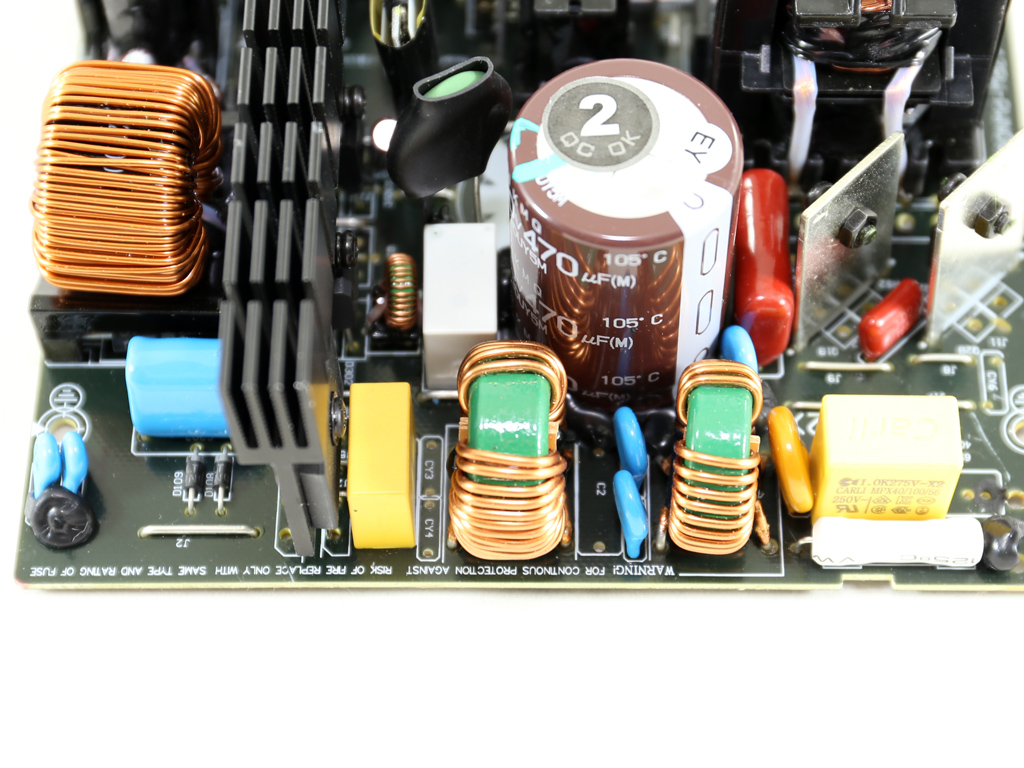


A small PCB behind the AC receptacle is empty of components. Its only job is to hold the socket and power switch. The EMI filter is located on the main PCB, including two pairs of Y caps, two X caps, a couple of CM chokes and an MOV. There is also an NTC thermistor, which lowers the inrush currents during the start-up phase. An electromagnetic relay is used to bypass the thermistor once it finishes its job.







A single bridge rectifier fully rectifies the incoming AC signal to a full wave signal with double the frequency of the AC input. Unfortunately, the bridge rectifier's markings are on its hidden side, and we try to avoid desoldering these type of parts since they are extra sensitive to increased heat. The sink that holds the rectifier also cools down the APFC's boost diode, a CREE C3D04060A, along with an Infineon IPI50R140CP FET that chops the rectified signal into constant pulse sequences. Usually a couple of FETs are used in the APFC converters of even lower-capacity PSUs. However, in this case, Super Flower cuts cost and only implements one. Two FETs could possibly improve efficiency, especially at higher loads. The load would would be shared among them, leading to less heat dissipation because each FET would handle fewer amps.
Finally, the APFC controller is an NCP1653A provided by ON Semiconductor. It's installed on a small vertical PCB and is covered by insulation tape in order to decrease EMI noise.



The single APFC cap is manufactured by Chemi-Con (400V, 470uF, 2000h @ 105 ° C, KMQ) and its capacity is low according to the results of our hold-up tests. Since there is space for an additional bulk cap, it is a shame that Super Flower doesn't equip this unit with a couple of them, but instead alters the power good signal's operation to make it drop after, and not before, the rails go out of spec.
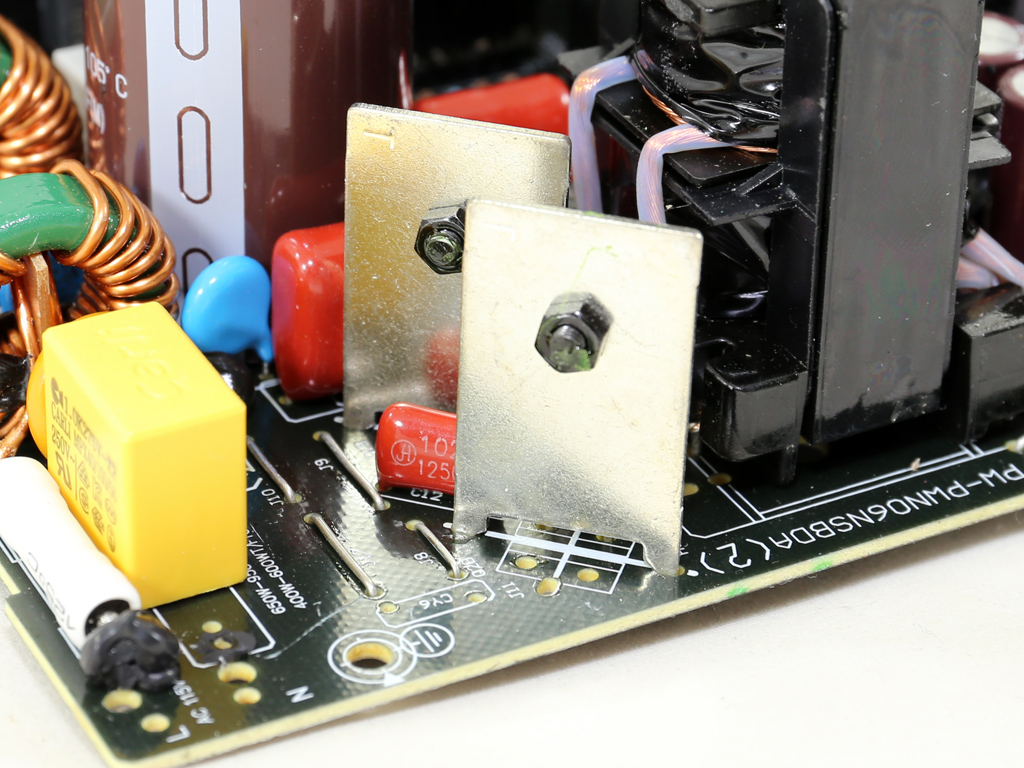



The main switchers are a couple of Infineon IPI50R199CP FETs. Both are installed on two small dedicated heat sinks and are arranged in a half-bridge topology. Super Flower uses an LLC resonant converter to boost efficiency, as it provides almost lossless switching to the main FETs. The LLC resonant controller, which also drives the +12V FETs and handles the PSU's protections, is a proprietary IC with the model number AA9013. It's made by Super Flower and there is no information available about its specifications. The AA9013 IC is installed on a vertical daughterboard located right next to the VRMs generating the minor rails. On the same daughterboard there is also an LM324ADG quad operation amplifier (op-amp), which most likely assists the AA9013 in enabling protection features.
Get Tom's Hardware's best news and in-depth reviews, straight to your inbox.


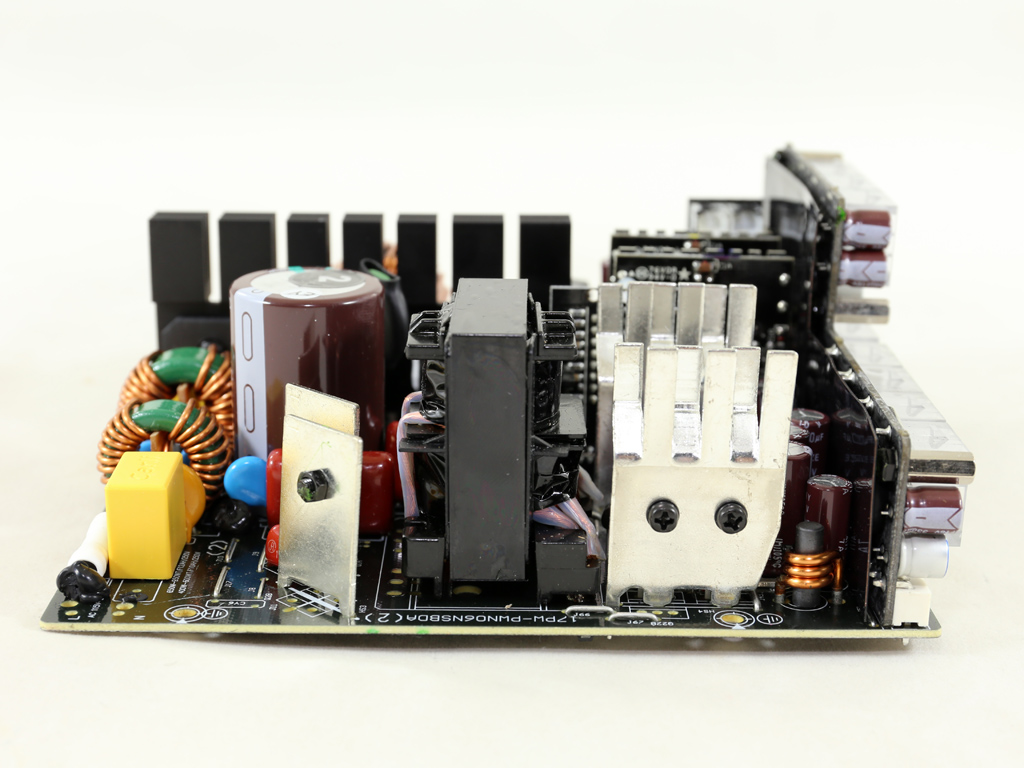
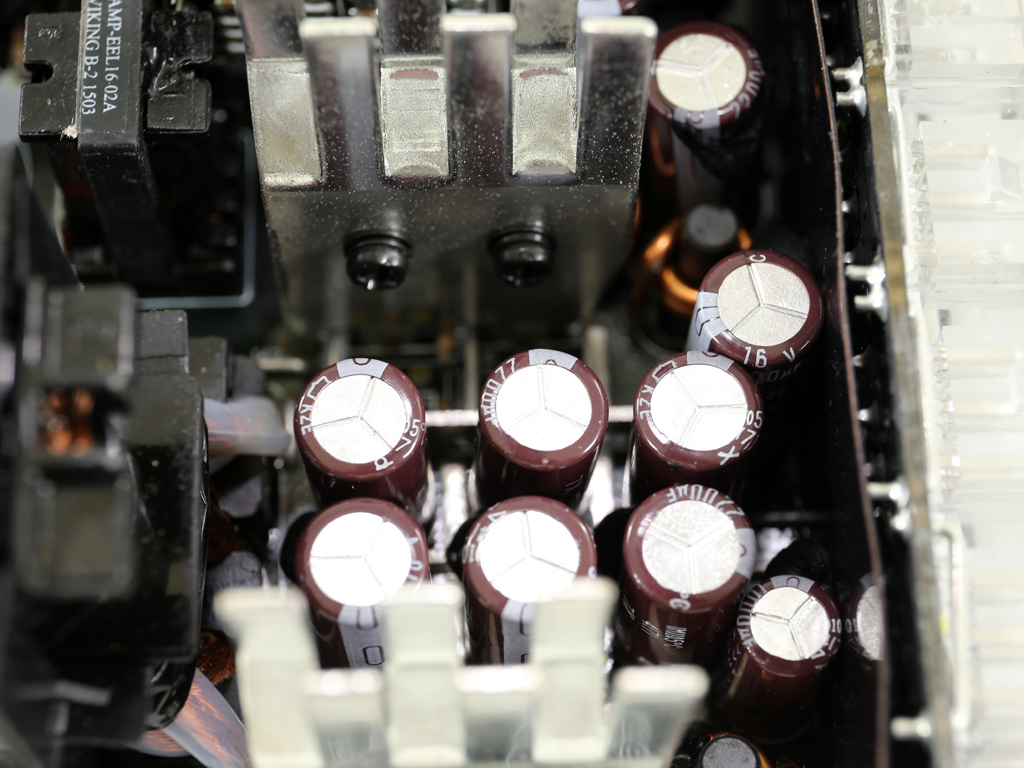

Two small heat sinks on the secondary side host four Infineon IPP041N04N G FETs that regulate the +12V rail. In this area, we find several filtering electrolytic caps along with a single polymer cap provided by Nippon Chemi-Con. All of the electrolytic caps are rated at 105 °C and have 2000 hours lifetime at this temperature; at normal temperatures they'll last much longer (a 10 °C difference in operating temperature can double or cut in half a capacitor's expected lifetime).

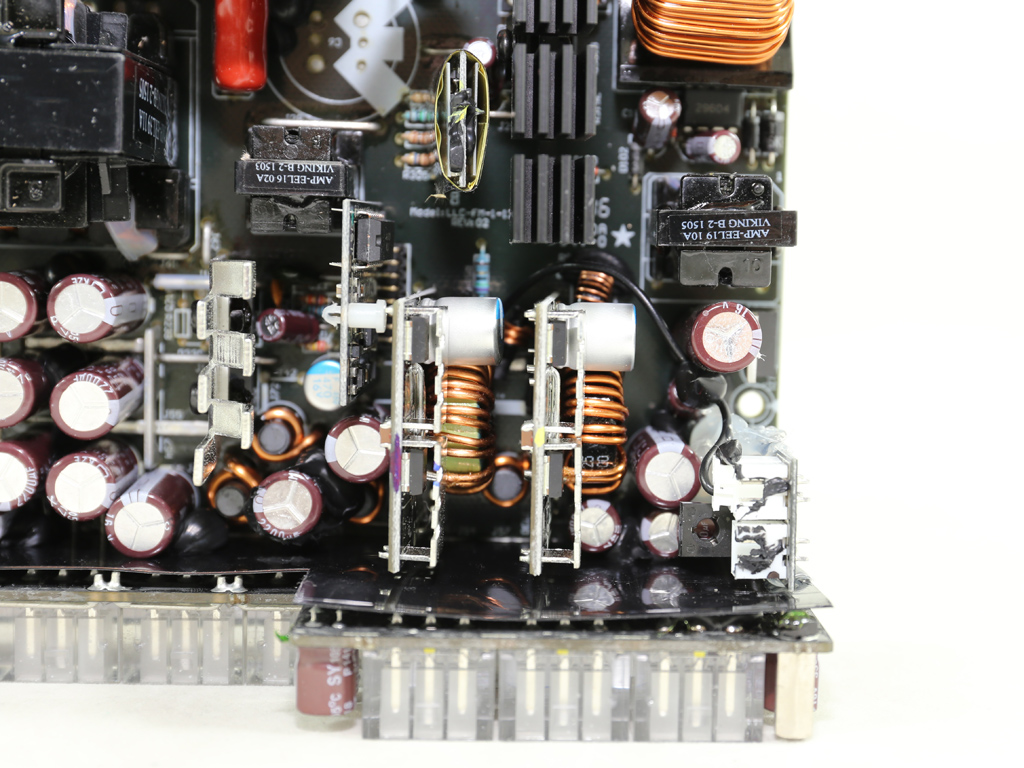

A couple of DC-DC converters, which are fed by the +12V rail, generate the minor rails. Each one is housed on a vertical PCB and uses a pair of Infineon IPD060N03L G FETs and an NCP1587A PWM controller. Metal shields surround the FETs in an effort to increase EMI protection.


Right in front of the VRMs is the fan controller's PCB, which houses an LM324ADG op-amp. Because the base of this PCB can easily break once you try to detach the fan header, the first thing we do every time we encounter a Leadex platform is apply lots of glue to secure it. Next to the fan control PCB is a Mospec S10C60C SBR that handles the 5VSB rail. The PWM controller is a small IC with a "29604" marking.


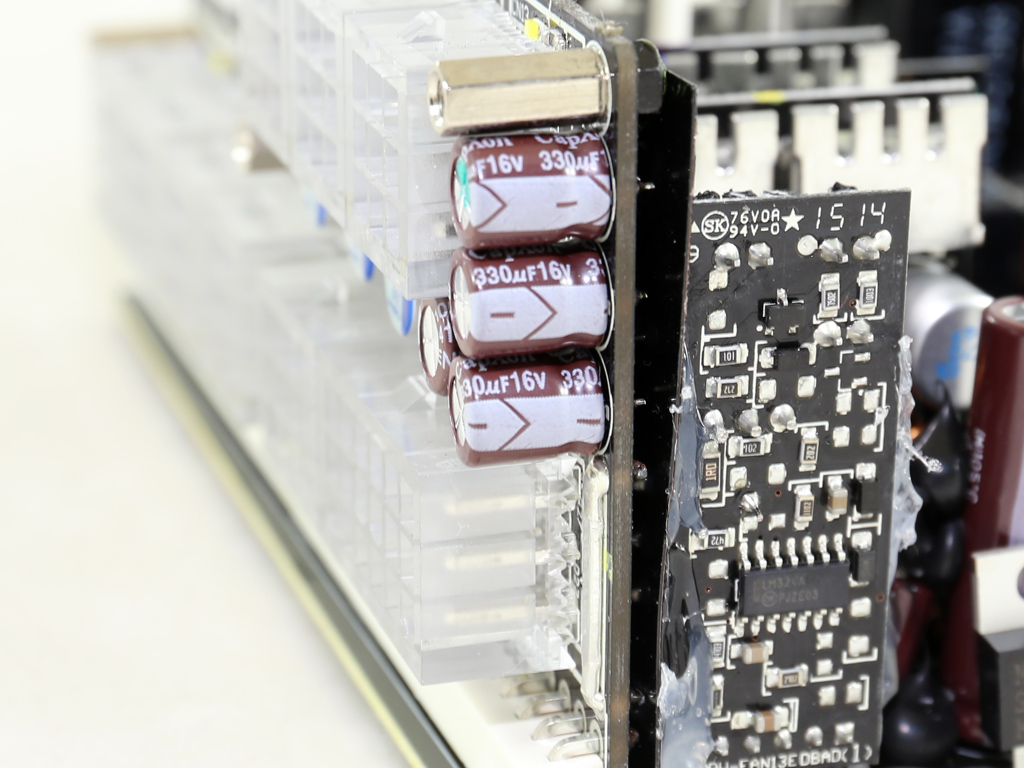
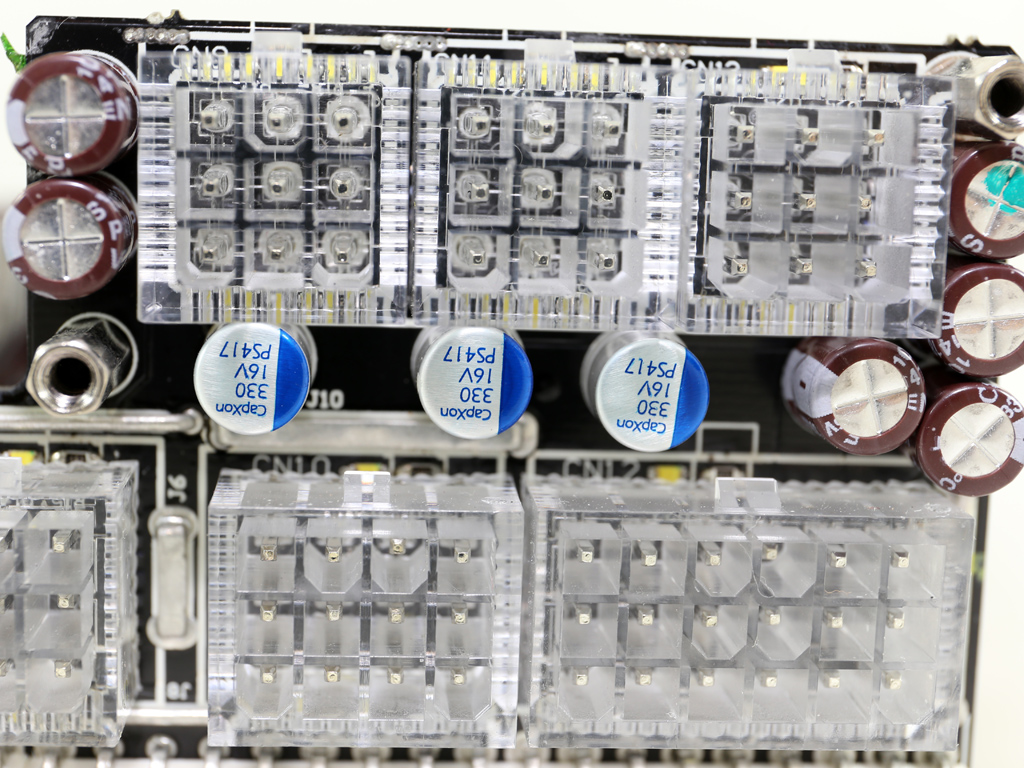
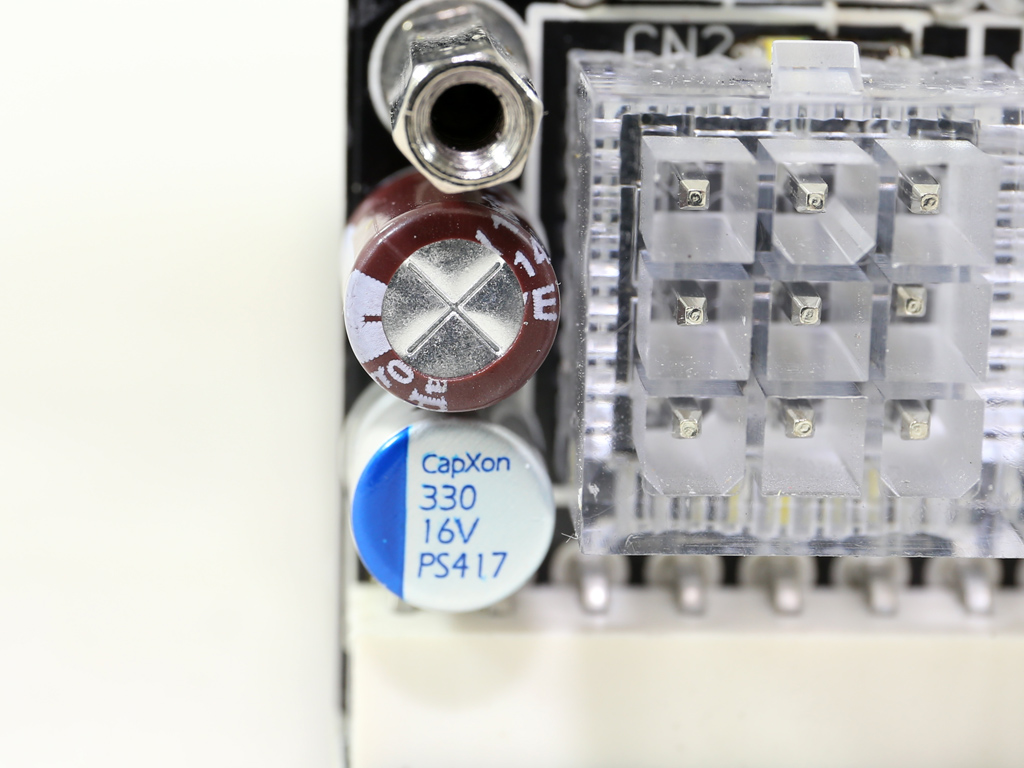
At the face of the modular PCB a nasty surprise awaited us. Super Flower uses several CapXon electrolytic and polymer capacitors, rather than the Japanese ones we're prefer to see. Although the capacitors in this area don't get stressed much (since most of the filtering is done by capacitors on the main PCB), we still believe Super Flower should avoid using CapXon caps. If the company wanted to cut manufacturing costs, it could have used Teapo caps, which are more highly regarded.

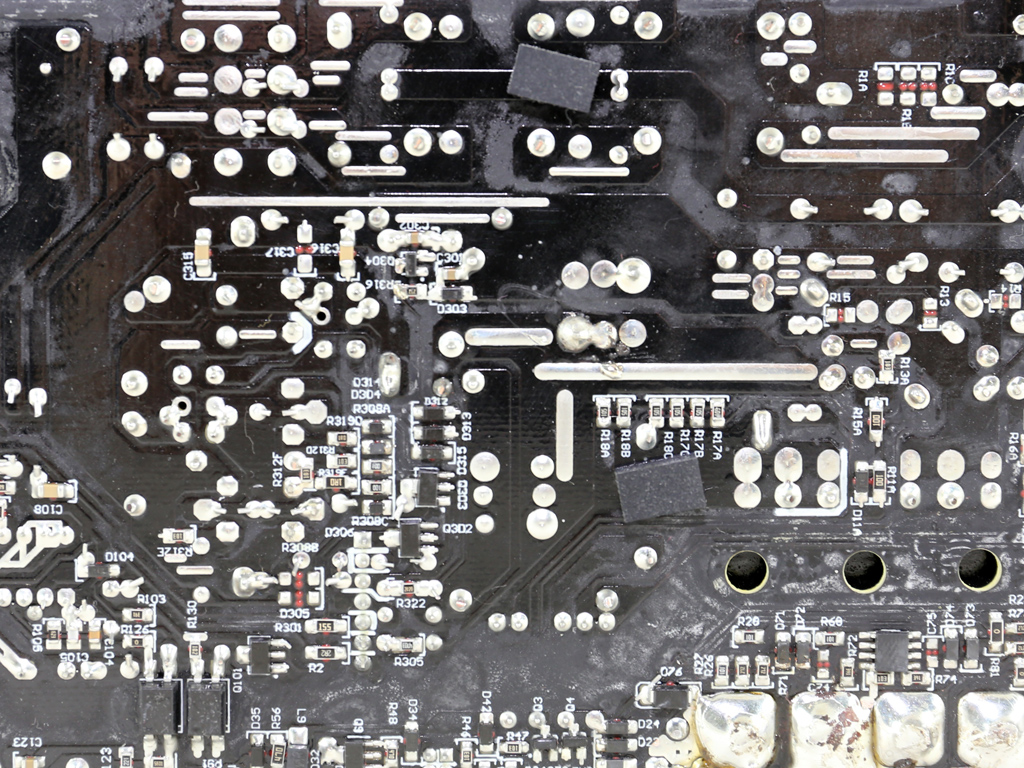





Soldering quality is good overall. However, we noticed ugly-looking joints in some spots. This shouldn't affect the PSU's operation, however.
The cooling fan is made by Globe Fan and its model number is RL4Z-B1352512M (135mm, 12V, 0.28A, 1200 RPM, 90.68 CFM, 23.3 dB[A]). The EVGA 550 G2 is equipped with a larger, 140mm fan (RL4Z-B1402512M) that's a little noisier. At normal operating temperatures, the fan profile is relaxed. Its semi-passive mode helps minimize acoustics under light loads. Some enthusiasts prefer Fluid Dynamic Bearing (FDB) fans instead, but a good quality double ball-bearing fan like this one is perfectly fine.
Current page: A Look Inside And Component Analysis
Prev Page Packaging, Contents, Exterior And Cabling Next Page Load Regulation, Hold-Up Time And Inrush Current
Aris Mpitziopoulos is a contributing editor at Tom's Hardware, covering PSUs.
-
blazorthon Granted the EPS and PCIe wires don't see very high current in most situations (especially the EPS with Haswell or Skylake CPUs), I hardly ever see other PSUs using thinner gauge wires, so I can't imagine it saving enough money to be worth going thinner than the recommended 18 gauge wires most other PSUs have regardless of capacity.Reply -
Quaddro Why crapxon?Reply
I'm tired to see bulged crapxon..
If this one use jap caps, it'll be absolutely perfect.. -
mctylr ReplyUnfortunately, the bridge rectifier's markings are on its hidden side, and we try to avoid desoldering these type of parts since they are extra sensitive to increased heat
Huh? Since when are bridge rectifiers particularly heat sensitive? I would say that bridge rectifiers are not worth the hassle to desolder, unless you suspect it was an underrated part.
APFC controller is an NCP1653A provided by ON Semiconductor. It's installed on a small vertical PCB and is covered by insulation tape in order to decrease EMI noise.
That looks like paper and vinyl / PVC electrical tape wrapped around the vertical PCB, which provides electrical isolation only, I doubt it would make measurable difference in EMI. -
Aris_Mp According to my experience so far they are, unfortunately.Reply
This provides some EMI protection. There is no need for electrical insulation on this board. As for the degree or EMI protection I can examine this with my EMC probes (once I find the time to do it). -
Andi lim this review said uses a half-bridge topology, I only see one main capacitor. half bridge usualy uses 2 main cap and 2 main switcher right ?Reply -
Aris_Mp the number of APFC caps has nothing to do with the primary topology. However yes half-bridge uses 2 switchers.Reply -
Andi lim You are right, this is half bridge with LLC series resonant converter, nothing wrong with the primary capacitor.Reply
